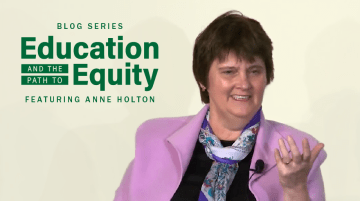Fifty Years After Kerner, It’s Time to Finish What We Started

My family likes to say we helped integrate Richmond, VA’s schools in 1970. It is part of our family lore, and a moment we are all immensely proud of. Sadly, the claim is not entirely true. Let me explain.
When I grew up in Richmond, VA, in the 1970s, in many ways it still felt like the capital of the Confederacy. In 1969—one year after the Kerner Commission Report came out—my father, Linwood Holton, was elected Governor of Virginia—the first Republican Governor of the Commonwealth since Reconstruction. In his inaugural address, he announced that he wanted to advance racial reconciliation in Virginia, and he began right away, appointing African Americans to key roles in state government effectively for the first time. And just a few short months later, he had another opportunity to deliver on his promise. Richmond’s schools were ordered integrated via cross-town bussing. My siblings and I were assigned to schools that were formerly all African American. Even with bussing, they pretty much stayed that way initially, because so many White people fled the school system. But within a few years, they became at least a little more diverse.
Today, however, Virginia and our nation have walked back from my father’s promise. My former school is no longer integrated, not even a little. Before my siblings and I attended Mosby Middle School (then named after a Confederate hero), it was 100% African American. Today, it’s Martin Luther King Middle School, and once again virtually 100% African American—and almost all its students are also from low-income families.
Richmond never really succeeded fully in integrating city schools. Today, there are only a handful of schools in the city that are diverse. My children attended some of those schools and received great educations there. But the vast majority of the city schools are segregated by income and by race. Ironically, the surrounding suburban areas (to which many White people fled to avoid bussing in the 1970s) have gone from being entirely White to having significant racial diversity—diversity that’s reflected in their student populations. Certainly, there is room to integrate further, but there are also working examples of healthy, integrated, culturally and economically and racially diverse schools that are delivering great education.
And that diversity extends beyond just Black and White. The Richmond City Schools and schools in the surrounding jurisdictions have also seen a large influx of new Americans. When I was a kid, the Richmond city population was largely White and Black. There was no Brown. There was no anything else. That’s not because we didn’t see it. It simply wasn't there. Today, in Richmond, and across Virginia, diversity really means diversity, with people from hundreds of racial and ethnic backgrounds. And that is truly a point of strength.
The schools in those diverse communities are providing kids with the kind of education you can’t get in a segregated school where every child has the same background. Yes, we are still seeing achievement gaps, but we are also seeing them close.
The schools in those diverse communities are providing kids with the kind of education you can’t get in a segregated school where every child has the same background. Yes, we are still seeing achievement gaps, but we are also seeing them close. And we are seeing academic achievement increase in students across all populations.
This is happening in our public schools. The ones created to serve every child. One of those schools is a regional magnet school called CodeRVA Regional High School that identifies diversity as an express value and has built it into the system. All of our schools should be like this. All of our communities should be like this. Because of its focus on science and mathematics, CodeRVA is also helping address inequities in opportunity, helping bring a more diverse population into technology fields. This effort, unsurprisingly, is supported by the local business community.
If people of good conscience come together and insist on it, we can find the public and political will to address these and other inequities and build a new American community, a “woke” community, and a more just and equal society. It’s time to pick up again and finish what the Kerner Commission, Lyndon Johnson, my father, and so many others started.
Anne Holton is a Visiting Professor of Education Policy at George Mason University and former Virginia Secretary of Education.
